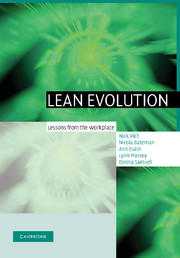Book contents
- Frontmatter
- Contents
- List of boxes
- List of figures
- List of tables
- Glossary
- 1 Introduction
- 2 Understanding the lean journey
- 3 Understanding your organisation
- 4 Laying the foundation stone of CANDO
- 5 Visual management and performance measurement
- 6 Problem solving, TQM and Six Sigma
- 7 Pull systems
- 8 Total productive manufacturing (TPM)
- 9 Sustainability
- 10 Group learning
- 11 Reflections and future challenges
- References
- Index
6 - Problem solving, TQM and Six Sigma
Published online by Cambridge University Press: 17 August 2009
- Frontmatter
- Contents
- List of boxes
- List of figures
- List of tables
- Glossary
- 1 Introduction
- 2 Understanding the lean journey
- 3 Understanding your organisation
- 4 Laying the foundation stone of CANDO
- 5 Visual management and performance measurement
- 6 Problem solving, TQM and Six Sigma
- 7 Pull systems
- 8 Total productive manufacturing (TPM)
- 9 Sustainability
- 10 Group learning
- 11 Reflections and future challenges
- References
- Index
Summary
If you work in industry or commerce today, then the topic of ‘quality’ will be part of your business language. Quality is an order qualifier, something demanded and expected by customers and the cost of poor quality is quite often a measurement at the highest level of an organisation (Hill, 1985). This is not surprising when figures such as 40% of the total cost of doing business is attributed to avoidable activity due to rework, scrap and rejects. Known as the ‘hidden factory’, this describes the multitude of, mostly, small activities which make up a significant cost to business, but are unnecessary. A waste of resource, worse still, a source of frustration between employees and across the different levels of an organisation.
This chapter will briefly outline the role of quality in a lean transition and its place in supporting such a transition. We are aware that the concept of quality is discussed in many guises and often as ‘initiatives’ by management authors, and, for the most part, these initiatives are considered old and staid. Quotes, from line workers and managers, that ‘we did TQM in 1996’ are not uncommon and reinforce the idea that this type of approach is a ‘tick in the box’ exercise. However, ‘world class’ businesses, and those determined to become world class, know well that quality management lies at the heart of all improvement activity.
We know that to maintain performance we need to continue focusing on a task.
- Type
- Chapter
- Information
- Lean EvolutionLessons from the Workplace, pp. 95 - 121Publisher: Cambridge University PressPrint publication year: 2006



